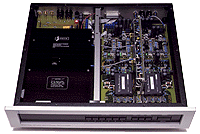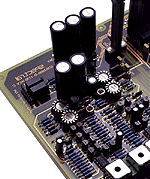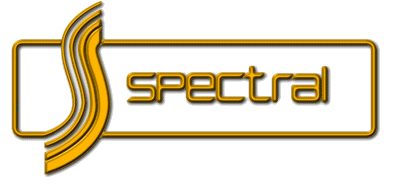The Spectral SDR-2000 Professional Reference Processor represents an uncompromised commitment to provide uniquely satisfying music reproduction with unprecedented transparency and resolution. With high definition compatible digital technology, or HDCD processing, the sonics of compact discs through the SDR-2000 become exemplary. To accomplish this, all aspects of signal handling, decoding, clocking and conversions are realized to near theoretical limits. Only then can the exacting technical and sonic performance occur to fully utilize HDCD capability when reproducing standard or coded recordings.
|
|
Spectral's engineering team has played an important part in the research and development of HDCD. This work reinforced a vision that superb digital sound was possible along with an awareness of the difficulty to achieve transcendent analog like reproduction. Development of the SDR-2000 commenced with knowledge that once losses from insufficient bit coding and sampling rate compromise could be reduced to inaudibility, as they are with HDCD process algorithms, then a much more thoroughly designed and implemented converter capable of greater information handling and accuracy is mandatory.
|
|
Traditional Conversion Methods
Prior to this new technology, conversion to and from the digital domain was thought accurate when distortion products were near to the theoretical limits posed by industry standards. Since modern systems rarely approach even this performance level, master recordings are generally made with converters operating more bits and higher sampling rates than can be coded to the Compact Disc release product. These traditional methods help alleviate hardware limitations by decimating or discarding fast signal components and high resolution information not recordable to the CD Format. Both operations reduce costs as digital filtering reduces analog circuit requirements and dithering allows larger bit errors. Grainy quantization distortions are mostly removed, but unfortunately these methods inherently add high frequency noise to the recording which often degrades the sound of low cost players.
|
|
Other economic trade-offs are made at the digital signal processor or filter used in almost all reproducers. These parts perform successive numeric operations to smooth or interpolate discontinuous steps of samples recorded on the CD. Practical filters have data truncation, short word lengths, and reduced numbers of multiplications thereby making the expensive arithmetic sections of the processor smaller and less complex. Such frugal measures create incomplete filters as well as round off errors so that even the best implemented systems will still produce a lifeless and claustrophobic dull/brittle digital character to the sound.
|
|
HDCD Technology
HDCD recordings are made from analog to digital conversions having more bits and faster sampling to provide a large amount of dynamic and resolution information. Digital signal processors then identify corrective actions or fixes to prevent losses and distortions when this information is reduced to the CD format. Some of these fixes are directly coded to the linear PCM data of the compact disc thereby improving performance from all players. Others are converted to a hidden code and sent through a buried information channel to the HDCD process chip in the SDR-2000. Upon processing, the normally lost micro level resolution signals are restored. This improved resolution requires conversion accuracy and jitter performance much better than traditional engineering and design practice. A very carefully and thoroughly executed process system is needed to fully utilize the HDCD filter technology.
|
|
SDR-2000 Professional Processor
The SDR-2000 Professional Reference Processor fulfills these exacting requirements beyond any other system. Its push pull 20 bit discrete circuit conversion and smart clocking systems provide almost 1 million times resolution dynamics with parts per million accuracy. Operating from a microprocessor controlled HDCD decoder, the converter can provide fast powerful infrasonic orchestral peaks and subtle reverberation down to molecules of air. Active temperature control of computer selected precision metal film parts and supersonic dithered parallel bit conversion assure that this resolution accuracy is maintained under all program and thermal conditions. Other features include slew controlled sampling which guarantees resolution for intense high frequencies. This accuracy under dynamic conditions is much better than can be provided by integrated circuit converters and amplifiers of any kind. It assures that complex music remains clear, articulate, and smooth as well as unbroken no matter how loud or soft.
|

|
Such leading edge performance comes from experience, creative no holds barred design, smart assembly methods and painstaking attention to detail. Spectral's first digital audio product, the SDR-1000 Disc Playback System, established preeminence and was a competitive reference for almost 6 years. It had first of its kind direct clocked push pull conversion and optical isolation architecture still revered today. The SDR-2000 Reference Processor continues this innovation and performance legacy with the most precisely timed and accurately rendered conversion in the audio industry.
|
|
Instrumentation Practices
To accomplish this, instrumentation design and construction practices are used throughout. Like the best spectrum analyzers, the SDR-2000 operates in a sealed enclosure having intricate internal baffles and shields. These structures define component groupings which are placed so that functional activities become segregated, confined and essentially non-interactive to each other. Further isolation is assured by multiple powering using custom transformers having ultra low coupling through their internal windings and case. All functional groups are electrically detached from one another by floating regulators and high speed optical couplers. In this manner cross coupling of timing clocks, digital data and decoded signals becomes virtually nonexistent thereby assuring analog like sonics. In addition, the mechanical structures creating these functional groupings provide thermal transfer points to the outside enclosure. This allows an active thermal management servo-system to assure that temperatures match those of laboratory set-up and factory calibration. Then conversion accuracy for the smallest signal changes is assured for wide dynamic conditions.
|

|
Fully Discrete Circuitry
All of today's high-end processors use monolithic IC DACs or integrated circuit chips for the analog stages such as summation and output amplifiers, usually both. Until now there has been no alternative to the universal compromise of using integrated circuits in critical sections. The SDR-2000 eliminates the problems of integrated circuits from DAC to output with the development of the industry's first discrete DAC and summation amplifier for use in a digital processor.
|
|
In the SDR-2000, Spectral's ultra fast discrete circuit amplifiers are used for all analog functions. Each is an optimum configuration for its function and all are constructed from selected top percentile components made from many different semiconductor fabrication processes. Active devices include J-Fets, D MosFets, as well as single and triple diffused high frequency bipolar transistors. Each Spectral discrete amplifier uses the best properties of these devices in floating cascade configurations where their isolation and speed capabilities are ideally suited for digital audio. These high-speed discrete amplifiers provide tremendous performance advantages over integrated circuit chips used in virtually all other high-end processors. Though cost effective, ICs suffer performance degradations resulting from their manufacturing processes which limit the types and performance of active devices within.
|
|
State of the art processor performance is only possible using precision discrete components in the analog and DAC stages. Any circuit compromise will cause digital activity to interact and crossover into the audio path. Equally destructive signal induced time modulation can create conversion jitter to further degrade sound. Such non-interaction in a very harsh digital audio signal environment requires very low distortion from complex signals, extremely quick and complete settling after a transient event, as well as minuscule phase variations in the presence of signal. These performance features are unequaled in the SDR-2000.
|
|
Digital to Analog Conversion
The SDR-2000 digital to analog converter DAC is custom made for Spectral using metal film discrete component construction and parallel conversion architecture. When operating with the HDCD decoder it not only achieves dynamic and high power clarity advantages of balanced multi-bit conversion but also low level ambiance and lack of grainy sound, features of one bit conversion. Both combined provide transcendent analog like reproduction with resolution and precision under all program conditions. No other processor utilizes this unique proprietary combination of discrete fully balanced circuitry with HDCD filter technology.
|
|
Conversions from 20 bit data to interpolated signal level samples are made eight times for each compact disc data byte. This 20 bit 8 times oversampling sequence provides information equivalent to over one thousand times oversampling at one bit and unlike integrated circuit and single bit conversion devices, distortions will not increase with signal dynamics and program complexity.
|
|
Digital filtering or interpolation provided by the HDCD decoder smoothes the audio signal as well as reduces non-harmonic supersonic sidebands to prevent high frequency interaction in other components of the audio chain. Since the processing is still in the digital domain, each of the 8 oversamples from the HDCD filter is in itself a much smaller step occurring at a faster rate. Discrete switches, filters and amplifiers, unique with the SDR-2000 integrate or smooth these smaller oversample steps and hold the signal constant during a brief but potentially noisy transition to the next small step. Such operations are firmware programmed to the HDCD decoder chip and are timed to reduce switching uncertainty noise as well as slew induced energy pulses. Both improvements, not possible with ICs, reduce conversion jitter and provide a clear unbroken sound to instruments having powerful high frequency peak energy.
|
|
The Spectral TimeStar Clocking System
Digital audio conversion has two dimensions of accuracy, a precise signal level for each byte number and exact timing of each sample. No matter what program conditions occur, both must be very good at all times. Transports and their related interface circuits will have 100% accurate data but unfortunately, the noisy interactions from servos, as well as cable reflections and inappropriate designs create poor timing signals. Even the very best commercial digital receivers and phase lock parts when subjected to these jittery signals have inadequate rejection performance to match the better than 22 bit resolution capability of Spectral's discrete DAC system.
|
|
This micro resolution is important because the smallest signals a few millionths of a volt buried deep within background noise can influence audible perceptions. These lowest levels correspond to molecular motion at the eardrum and are part of learned ambient awareness and of life long experience to instrumental sound. During some program conditions, a reasonably astute listener will be aware of their removal or alteration. Distortion products from high frequency signals sampled with jittery timing have similar perceptual consequences. In time, an experienced listener might discern just 5 billionths of a second peak jitter. This performance is just within the resolution limits of an ideal 20 Bit converter. Unfortunately traditional digital interface circuits and data links have between 100 and 1,000 times more jitter. Consequently some high-end digital converters are constructed with a second interface or phase lock loop sub-system to reduce these timing errors. At best, such implementations still have an order of magnitude excessive jitter. Other methods such as those using digital memory as a precision clocked first in first out storage register do reduce jitter. However, their extensive noisy circuits must be carefully shielded and even then their activity may contaminate sensitive analog and clocking signals.
|
|
The Spectral SDR-2000 TimeStar smart clocking system is clever and elegant in its design and implementation. It yields sufficient jitter rejection to provide nearly ideal 10 billionths of a second accuracy. To achieve lowest possible noise, it uses a linear phase lock loop and crystal oscillator configuration as well as discrete circuit logic components. When combined to make a precision sub-system, these components deliver an exceptionally low noise clock waveform which does not have ripple and substrate interference. Its waveform purity meets all requirements for the precise framing of each sample. To prevent jitter contamination from transports and cables, an exceptionally long time constant three element filter is configured in the phase lock loop to reject these noises to well below that of other system parts. Spectral's unique smart programmed feed forward locking system rapidly stabilizes this otherwise self oscillatory configuration to allow the PLL to thoroughly reject outside disturbances. With this system, powerful high frequencies such as full ensemble brass and peaks of piano notes are reproduced clearly and unbroken, with exceptional inner detail.
|
|
In Conclusion
The SDR-2000 Professional Reference Processor is designed and built to fully utilize HDCD technology as well as accurately render advanced conventional recordings to near theoretical limits. Conversions, timing and isolations of cross coupling are precisely executed to provide micro resolutions of more than one million, an equivalent of nearly twenty two bits. Discrete circuits and controlled slew rate parallel converters using stable thermally controlled parts assure this accuracy for the most demanding program conditions. The SDR-2000 with HDCD processing effortlessly handles the opposites that have plagued digital audio. Inner detail and brilliant overtones, as well as spatial sense and dynamic clarity are brought together in a transparent smooth analog like presentation for the first time.
|
|

